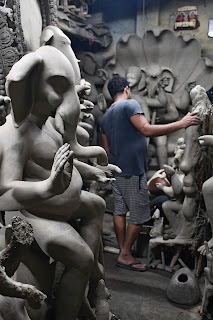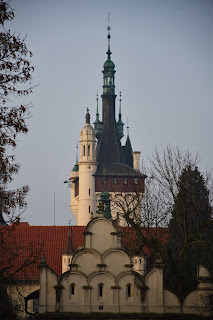India: Day 3 – An excursion to Northern Kolkata
I had another early start today and spent much of the morning writing posts for this blog. Since Sparsh’s grandfather had me sit at a different end of the table this time, I did not see the shrine very well, but I noticed that unlike yesterday, Durga received her beloved hibiscus blossoms and half a coconut. I also saw that when the priest came, he not only dressed the idols but seemed to put something like hair on their heads as well.
A little after nine
o’clock a small group of us (Victoria, Sophie, Sophie’s brother Julien, and I)
set off for the north of Kolkata to see two important temples. The first, about
an hour away by Uber, was the Belur Math complex. Associated with the nineteenth
century spiritual leader Ramakrishna and his disciples, it is the centre of the
worldwide Ramakrishna mission. A core tenet of this movement is that all
religions are fundamentally the same, and this principle is underscored by the
mixture of architectural styles used in the building of the main temple.
Right after passing
through the gates of the complex, we left our shoes at the shoe depository and
continued our excursion barefooted. The grounds were very well maintained. The
hedges were trimmed, the grass was mown, and the trees were kept well within
the bounds of where they were supposed to grow. For the first time since
visiting the Victoria Memorial, I felt safe and relaxed; the grounds were
staffed by many workers who kept the visitors from running amok.
We stopped by all four
of the major temples in the complex, which all seemed to be built around relics
associated with the major gurus of the Ramakrishna mission. Victoria and I also
briefly toured the mission’s museum, which houses a bizarrely extensive
collection of memorabilia associated with the movement’s luminaries. Besides
the obligatory personal objects, we saw the red-ink footprints of holy people
and miniatures of the houses where they stayed on their international tours.
As we could not find
an Uber that would take us to our next destination, we flagged down a
four-seater tuk-tuk. We thought we would have to barter on the price, but in
fact, upon being asked whether he would want 200 rupees for the ride, the
driver insisted we only give him one hundred. In the end, we gave him 200
anyway, as we were impressed by his honesty in heading away to get change for
the 500 rupees we procured.
As tuk-tuks are not
permitted to cross the Vivekananda bridge, the driver left us at the entrance
and we continued on foot. It was a very rewarding walk. On our way to the
Dakshineswar Kali Temple, we saw a range of scenes from daily life in the city,
like people bathing and washing their clothes in the river and sacrificial
goats waiting for their death in front of roadside shacks. Unfortunately, by
the time we arrived at the temple, the complex began to close for the daily
lunchtime siesta. Julien and Sophie managed to briefly get in while Victoria
and I guarded their things, and they saw a woman be violently possessed by the
spirit of the goddess.
I was chuffed to
introduce my friends to the metro system, whose blue line actually begins at
Dakshineswar. We rode it all the way to Park Street Station, near which we met
the rest of the group for lunch at Flavours of China, a famous restaurant with
a long history and an interesting Indian take on Chinese food.
We had some time to
kill between lunch and our evening programme, so we broke into smaller groups
again. Ludo, Sophie, Julien, and I took an Uber to the Jain temple of Parshwanath in city’s northeast. The interior was heavily decorated with ornate
tiles, mirrors and silver ornaments, making it glisten like an ice cave struck
by daylight. The grounds were also very striking: they contained numerous
decorations, and especially silver Baroque-inspired statues of female
divinities and mer-children.
Sparsh’s programme for
the evening was to visit part of Kolkata’s old town at Kumartuli, an area
famous for its manufacture of statues for the city’s festivals. During these
festivals, the heavily painted and brightly dressed statues are carried around
in processions before being thrown into the Hooghly River. The upcoming
celebrations will honour Ganesh and Durga. Consequently, many of the statues we
saw in the making depicted these two gods in recognisable poses: Ganesh sitting
and giving benediction, usually in front of his vehicle animal, the rat, and Durga
standing over her lion and a vanquished demon.








































Comments
Post a Comment